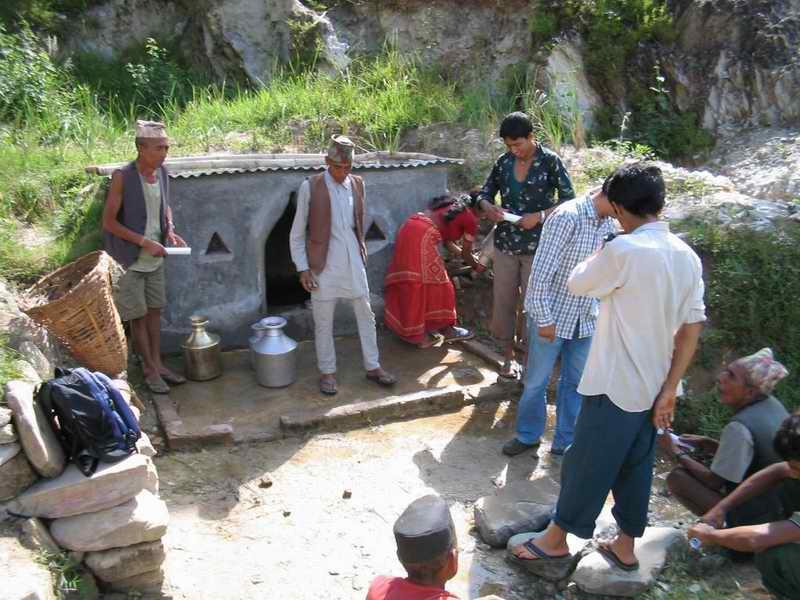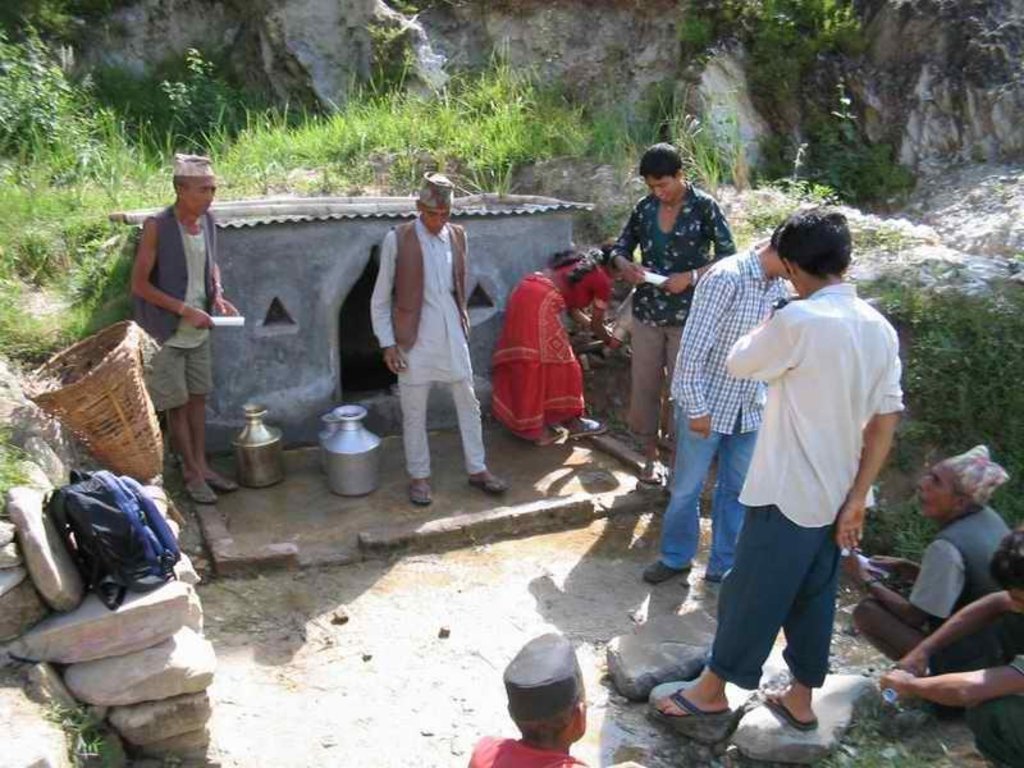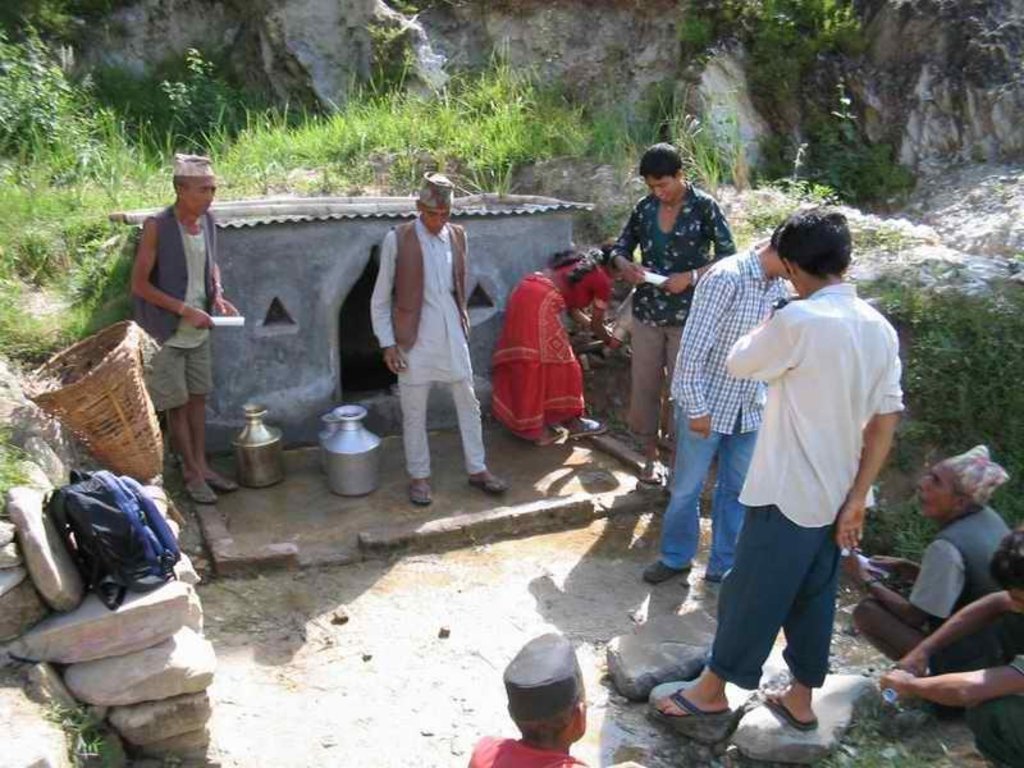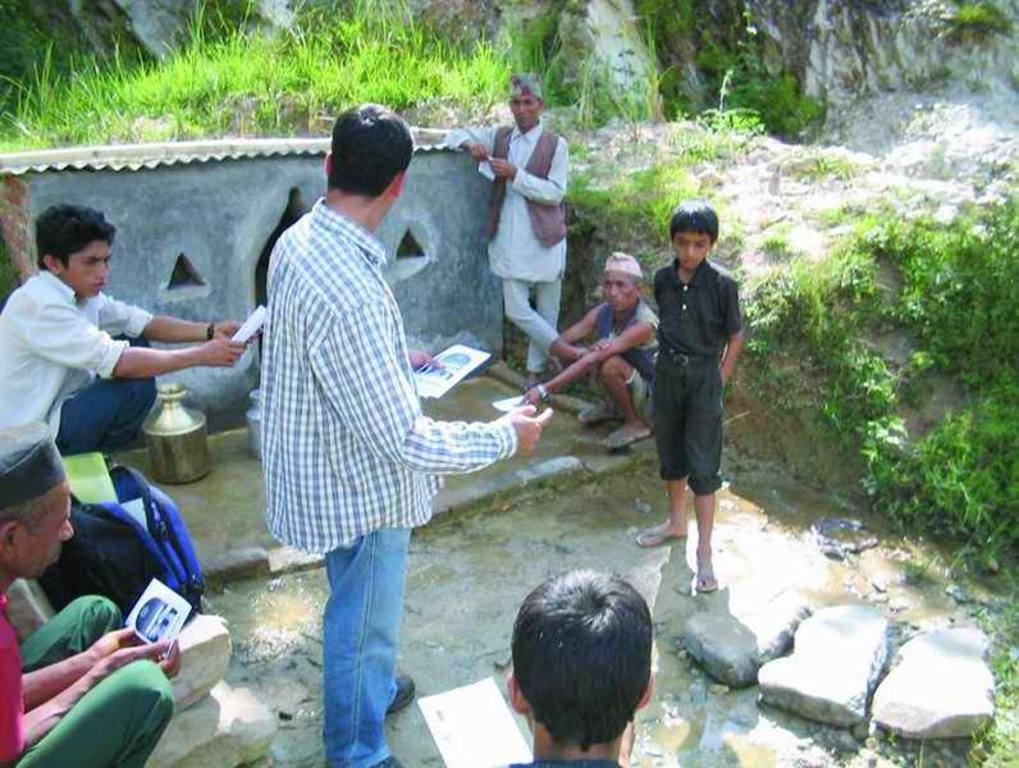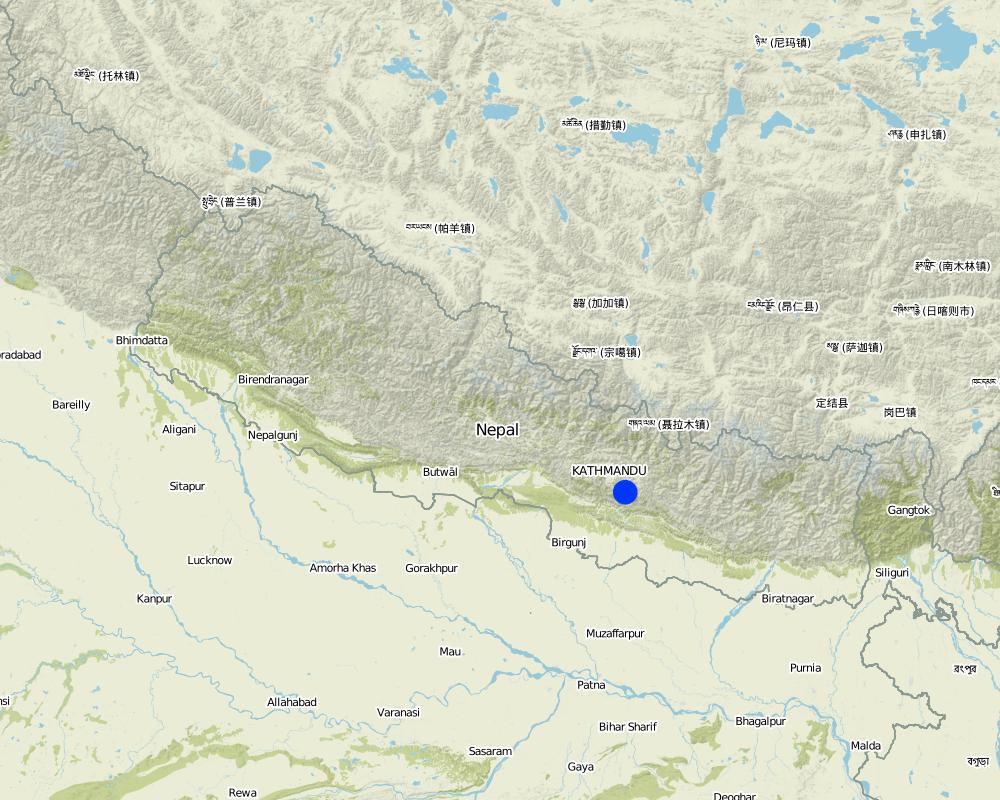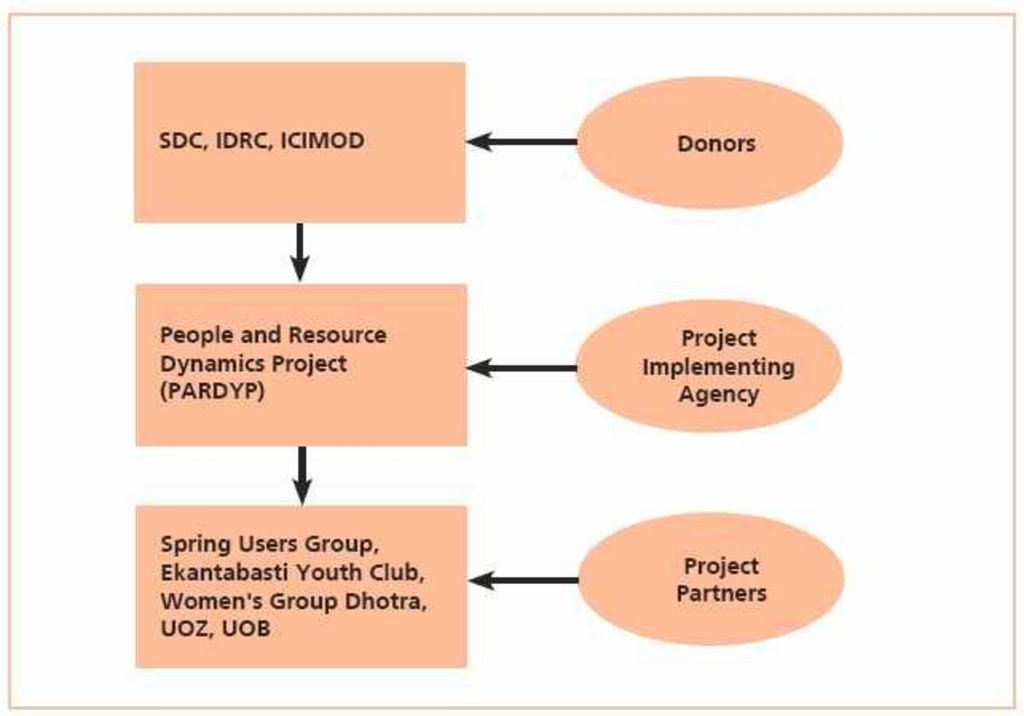Community efforts for improving drinking water quality [เนปาล]
- ผู้สร้างสรรค์:
- การอัพเดท:
- ผู้รวบรวม: Madhav Dhakal
- ผู้เรียบเรียง: –
- ผู้ตรวจสอบ: Fabian Ottiger
Piune paani ko gunastar sudhar ka lagi samudayik prayas
approaches_2352 - เนปาล
ดูส่วนย่อย
ขยายทั้งหมด ย่อทั้งหมด1. ข้อมูลทั่วไป
1.2 รายละเอียดที่ติดต่อได้ของผู้รวบรวมและองค์กรที่เกี่ยวข้องในการประเมินและการจัดเตรียมทำเอกสารของแนวทาง
ผู้เชี่ยวชาญ SLM:
Isabelle Provodoli
himcat@icimod.org
International Centre for Integrated Mountain Development (ICIMOD), GPO
Box. 3226, Kathmandu
เนปาล
ชื่อของโครงการซึ่งอำนวยความสะดวกในการทำเอกสารหรือการประเมินแนวทาง (ถ้าเกี่ยวข้อง)
CDE Centre for Development and Environment (CDE Centre for Development and Environment) - สวิตเซอร์แลนด์ชื่อของโครงการซึ่งอำนวยความสะดวกในการทำเอกสารหรือการประเมินแนวทาง (ถ้าเกี่ยวข้อง)
ICIMOD International Centre for Integrated Mountain Development (ICIMOD) - เนปาล1.3 เงื่อนไขที่เกี่ยวข้องกับการใช้ข้อมูลที่ได้บันทึกไว้ผ่านทาง WOCAT
ผู้รวบรวมและวิทยากรหลักยอมรับเงื่อนไขเกี่ยวกับการใช้ข้อมูลที่ถูกบันทึกผ่านทาง WOCAT:
ใช่
1.4 การอ้างอิงถึงแบบสอบถามเรื่องเทคโนโลยี SLM
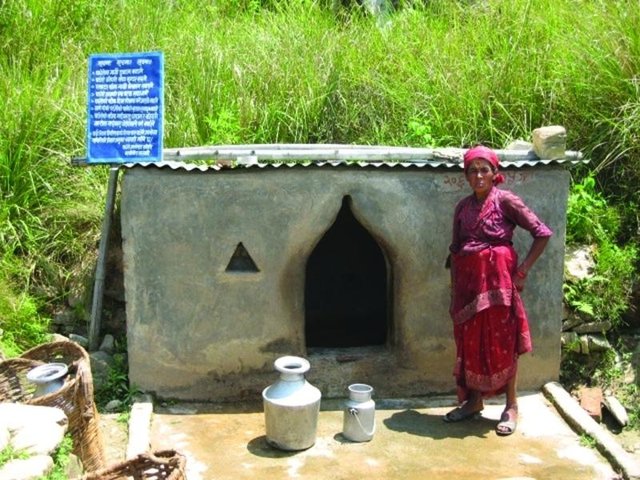
Drinking water quality improvement through conservation measures [เนปาล]
Structural and vegetative measures to improve the quality of drinking water contaminated due to poor sanitation and seepage
- ผู้รวบรวม: Madhav Dhakal
2. คำอธิบายของแนวทาง SLM
2.1 การอธิบายแบบสั้น ๆ ของแนวทาง
Working with communities to demonstrate and disseminate methods for improving drinking water quality using structural and vegetative measures
2.2 การอธิบายอย่างละเอียดของแนวทาง
การอธิบายอย่างละเอียดของแนวทาง:
Aims / objectives: The People and Resource Dynamics in Mountain Watersheds of the Hindu Kush- Himalayas Project (PARDYP) implemented this approach with 30 drinking water user households at Barbot in the Jhikhu Khola watershed, Kavre Palanchok. The aim was to improve water quality and availability from an open spring source through participatory planning and implementation. The approach first identified local concerns and observed the sanitary situation of the catchment area. Meetings were held jointly with men and women users from different caste groups (Brahmin, Chhetri, Newar and Kami) to discuss the problems and issues and to identify viable solutions. The advantages and disadvantages of the various options were discussed, after which users selected the following three measures to improve the drinking water supply: 1) building a brick-cement walled structure around the main local spring, 2) establishing check dams across nearby rills and gullies, and 3) planting grass around the spring box and tree saplings within the catchment area. The aim was to prevent direct flow of surface water into the spring and reduce contamination and turbidity of the source. Understanding and support was gained by demonstrating the technology and running an awareness campaign.
Role of stakeholders: The project helped form a users committee made up of 11 women and 1 man and encouraged them to plant grass and tree seedlings across the entire catchment. The project regularly measured the quality of the water and shared the results with the users. Rules and regulations were developed to ensure equitable access to the spring and its sustainable use and management. A notice board with do’s and don’ts was placed near the spring. The users held monthly meetings and established a revolving fund for maintaining the structures. Spring users followed the rules and regulations by washing, cleaning, and bathing at separate sources. Livestock grazing was stopped in the nearby area and the area was regularly cleaned. Furthermore, users were encouraged to treat water for drinking using simple methods like SODIS and the low cost Safa filter to avoid microbiological contamination. They were made more aware of water quality, sanitation, and health issues.
2.3 รูปภาพของแนวทาง
2.5 ประเทศ ภูมิภาค หรือสถานที่ตั้งที่ได้นำแนวทางไปใช้
ประเทศ:
เนปาล
ข้อมูลเฉพาะเพิ่มเติมของสถานที่ตั้ง:
Kavrepalanchowk district/ Jhikhu Kholawatershed
Map
×2.6 วันที่เริ่มต้นและสิ้นสุดของแนวทาง
การสิ้นสุดลง (ถ้าแนวทางไม่ได้ใช้อีกต่อไป):
2005
2.7 ประเภทของแนวทาง
- ใช้โครงงานหรือแผนงานเป็นฐาน
2.8 เป้าหมายหรือวัตถุประสงค์หลักของแนวทาง
The Approach focused on SLM only
- To explore and demonstrate appropriate water quality improving technologies and methods in a participatory way. - To increase awareness on water quality, water treatment, and health and hygiene. - To share knowledge gained on the water improvement options with farmers and other stakeholders
The SLM Approach addressed the following problems: Weak institutional collaboration to develop technological options for improving drinking water quality and availability and to raise awareness on health and hygiene and waterborne diseases.
2.9 เงื่อนไขที่เอื้ออำนวยหรือเป็นอุปสรรคต่อการนำเทคโนโลยีภายใต้แนวทางนี้ไปปฏิบัติใช้
การมีไว้ให้หรือการเข้าถึงแหล่งการเงินและบริการ
- เป็นอุปสรรค
For the maintenance of the implemented technology
Treatment through the SLM Approach: Revolving fund collected by users
การจัดตั้งระดับองค์กร
- เป็นอุปสรรค
Weak institutional collaboration
Treatment through the SLM Approach: User group formed linking local community organisations
กรอบแนวทางในการดำเนินการด้านกฎหมาย (การถือครองที่ดิน สิทธิในการใช้ที่ดินและน้ำ)
- เอื้ออำนวย
The existing land ownership, land use rights / water rights greatly helped the approach implementation: mostly state owned land and some private land - which helped implementating the technology as there was no conflict.
ความรู้เกี่ยวกับ SLM การเข้าถึงการสนับสนุนด้านเทคนิค
- เป็นอุปสรรค
Different water treatment methods
Treatment through the SLM Approach: Awareness of structural and vegetative measures; direct water treatment methods including Safa filter, SODIS, chlorination
3. การมีส่วนร่วมและบทบาทของผู้มีส่วนได้ส่วนเสียที่เกี่ยวข้อง
3.1 ผู้มีส่วนได้ส่วนเสียที่เกี่ยวข้องในแนวทางนี้และบทบาท
- ผู้ใช้ที่ดินระดับท้องถิ่นหรือชุมชนระดับท้องถิ่น
Land users worked equally divided between men and women
Improvement of drinking water quality and quantity was the major concern of all spring users.
- องค์กรพัฒนาเอกชน
- รัฐบาลแห่งชาติ (ผู้วางแผน ผู้ทำการตัดสินใจ)
- องค์การระหว่างประเทศ
PARDYP/ICIMOD
ถ้ามีผู้มีส่วนได้ส่วนเสียหลายคนที่เกี่ยวข้องให้ระบุหน่วยงานตัวแทน:
Concept designed by national specialist and implemented jointly with users
3.2 การเกี่ยวข้องของผู้ใช้ที่ดินระดับท้องถิ่นหรือชุมชนระดับท้องถิ่นในช่วงต่างๆของแนวทาง
| ความเกี่ยวข้องของผู้ใช้ที่ดินระดับท้องถิ่นหรือชุมชนระดับท้องถิ่น | ระบุผู้ที่มีส่วนเกี่ยวข้องและอธิบายกิจกรรม | |
|---|---|---|
| การริเริ่มหรือการจูงใจ | ปฏิสัมพันธ์ | public meetings; meetings organised to identify problems and possible options to overcome them. |
| การวางแผน | ปฏิสัมพันธ์ | public meetings; organised regularly to identify implementing steps, and role and responsibility of different stakeholders in overcoming problems |
| การดำเนินการ | ปฏิสัมพันธ์ | responsibility for major steps; the user group responsible for implementation and the project for technical support |
| การติดตามตรวจสอบหรือการประเมินผล | ปฏิสัมพันธ์ | The quality of the water was measured in each season to monitor the impact of the technology. Detailed progress reports, results, and lessons learned were shared with district level institutions and authorities, water quality reports were shared with spring users at public meetings |
| Research | ไม่ลงมือ | Water quality and availability recorded before and after technology implemented. Studies on access to water and confl icts among users |
3.3 แผนผังแสดงขั้นตอนการทำงาน (ถ้ามี)
คำอธิบาย:
PARDP project donors and implementing partners-- SDC: Swiss Agency for Development and Cooperation IDRC: International Development Research Centre ICIMOD: International Centre for Integrated Mo
ผู้เขียน:
Madhav Dhakal
3.4 การตัดสินใจเลือกใช้เทคโนโลยี SLM
ระบุผู้ที่ทำการตัดสินใจเลือกเทคโนโลยีมากกว่าหนึ่งวิธีไปปฏิบัติใช้:
- ผู้ใช้ที่ดินเป็นผู้ตัดสินใจหลัก โดยการสนับสนุนจากผู้เชี่ยวชาญ SLM
การอธิบาย:
Users selected three of the potential conservation options.
Decisions on the method of implementing the SLM Technology were made by mainly by land users supported by SLM specialists. The technology and associated measures were not new to the area and the implementing methods were simple and have been practised for a long time. The project initiated the formation of a users committee and the committee conducted the conservation activities.
4. การสนับสนุนด้านเทคนิค การสร้างขีดความสามารถ และการจัดการด้านความรู้
4.1 การสร้างขีดความสามารถ / การอบรม
ได้มีการจัดอบรมให้แก่ผู้ใช้ที่ดินหรือผู้มีส่วนได้ส่วนเสียคนอื่น ๆ หรือไม่:
ใช่
ให้ระบุว่าใครเป็นผู้ได้รับการอบรม:
- ผู้ใช้ที่ดิน
รูปแบบการอบรม:
- จัดการประชุมสู่สาธารณชน
หัวข้อที่พูด:
Concept of conservation measures, and methods of treating contaminated water using SODIS and safa filter.
4.2 การบริการให้คำแนะนำ
ผู้ใช้ที่ดินมีการเข้าถึงการรับบริการให้คำปรึกษาหรือไม่:
ใช่
ระบุว่ามีบริการให้คำปรึกษาหรือไม่:
- ไปเยี่ยมชมสถานที่
การอธิบาย/แสดงความคิดเห็น:
Name of method used for advisory service: Sharing information on water quality status, and raising awareness among users.; Key elements: catchment conservation, health hygiene, water treatment methods; 1) Advisory service was carried out through: projects own extension structure and agents; Extension staff: specifically hired project employees 2) Target groups for extension: land users; Activities: awareness on health hygiene; catchment conservation activities and water treatment methods were shared during meetings.
Advisory service is quite adequate to ensure the continuation of land conservation activities
4.3 การเสริมความแข็งแกร่งให้กับสถาบัน (การพัฒนาองค์กร)
สถาบันได้รับการจัดตั้งขึ้นมาหรือเสริมความแข็งแกร่งโดยแนวทางนี้หรือไม่:
- ใช่ เล็กน้อย
ระบุระดับของสถาบันที่ได้รับการเสริมความแข็งแกร่งหรือจัดตั้งขึ้นมา:
- ท้องถิ่น
ระบุประเภทของการให้ความช่วยเหลือสนับสนุน:
- การสร้างขีดความสามารถ / การอบรม
ให้รายละเอียดเพิ่มเติม :
Training on water quality treatment provided to local club
4.4 การติดตามตรวจสอบและประเมินผล
การติดตามตรวจสอบและประเมินผลเป็นส่วนหนึ่งของแนวทางหรือไม่:
ใช่
ความคิดเห็น:
bio-physical aspects were ad hoc monitored through observations; indicators: land use and degradation, sanitary inspection, history of spring, available resources to trap water
technical aspects were regular monitored through measurements; indicators: seasonal water quality and discharge
socio-cultural aspects were ad hoc monitored through observations; indicators: number of spring users, household water requirements, users' issues
no. of land users involved aspects were regular monitored through measurements; indicators: participation in conservation activities
There were few changes in the Approach as a result of monitoring and evaluation: The project consulted with the local women's cooperative to solve a conflict over water quantity and access to spring source.
4.5 การวิจัย
การวิจัยเป็นส่วนหนึ่งของแนวทางหรือไม่:
ใช่
ระบุหัวข้อเรื่อง:
- สังคมวิทยา
- เทคโนโลยี
ให้ข้อมูลเพิ่มเติมและให้ระบุผู้ทำการวิจัย:
Access to drinking water, conflicts at water fetching times, water quality and quantity measurement, and effectiveness of water treatment methods.
Research was carried out on station
5. การสนับสนุนด้านการเงินและวัสดุอุปกรณ์
5.1 ระบุงบประมาณประจำปีสำหรับแนวทาง SLM นี้
ถ้าหากว่างบประมาณประจำปีไม่เป็นที่ทราบแน่นอน ให้ระบุช่วงลงไป:
- < 2,000
แสดงความคิดเห็น (แหล่งของการระดมทุน ผู้บริจาคคนสำคัญ):
Approach costs were met by the following donors: international (SDC, IDRC, ICIMOD): 90.0%; local community / land user(s) (users group): 10.0%
5.3 เงินสนับสนุนสำหรับปัจจัยนำเข้า (รวมถึงแรงงาน)
- อื่น ๆ
| อื่นๆ (ระบุ) | เห็นด้วยระดับไหน | ระบุเงินสนับสนุน |
|---|---|---|
| Planting materials |
ถ้าแรงงานโดยผู้ใช้ที่ดินเป็นปัจจัยนำเข้าที่มีอยู่มากมาย ระบุด้วยว่าเนื่องจาก:
- สมัครใจ
ความคิดเห็น:
In implementing the technology and the approach
5.4 เครดิต
มีการจัดหาเครดิตมาให้ภายใต้แนวทาง SLM หรือไม่:
ใช่
6. การวิเคราะห์ผลกระทบและการสรุป
6.1 ผลกระทบของแนวทาง
ช่วยให้ผู้ใช้ที่ดินนำเอาเทคโนโลยี SLMไปใช้และบำรุงรักษาสภาพไว้ได้หรือไม่:
- ไม่ใช่
- ใช่ เล็กน้อย
- ใช่ ปานกลาง
- ใช่ อย่างมาก
To build awareness on SLM and methods of improving drinking water quality. It also helped users to work in a group.
Did other land users / projects adopt the Approach?
- ไม่ใช่
- ใช่ เล็กน้อย
- ใช่ ปานกลาง
- ใช่ อย่างมาก
Similar approaches are being followed in other communities across Nepal.
6.2 แรงจูงใจหลักของผู้ใช้ที่ดินเพื่อที่จะนำ SLM ไปปฏิบัติใช้
- ภาระงานลดลง
due to reduced water fetching time (or distance).
- จิตสำนึกด้านสิ่งแวดล้อม
Improved heath due to clean water and better sanitation
6.3 ความยั่งยืนของกิจกรรมของแนวทาง
ผู้ใช้ที่ดินสามารถทำให้สิ่งต่างๆ ที่ได้ปฏิบัติใช้โดยแนวทางนี้ยั่งยืนได้หรือไม่ (โดยไม่มีการสนับสนุนจากภายนอก):
- ใช่
ถ้าตอบว่าใช่ ให้อธิบายว่าอย่างไร :
Users are maintaining the implemented technology and also protecting the other nearby spring sources.
6.4 จุดแข็งและข้อได้เปรียบของแนวทาง
| จุดแข็ง / ข้อได้เปรียบของแนวทางในทัศนคติของผู้ใช้ที่ดิน |
|---|
| Water users committee formed, revolving fund collected, and rules and regulations developed for the sustainable management of the drinking water system (How to sustain/ enhance this strength: Maintain links with local community mobilisation groups for continuous guidance and support for the user group and for the proper use of the revolving fund.) |
| จุดแข็ง / ข้อได้เปรียบของแนวทางในทัศนคติของผู้รวบรวมหรือวิทยากรหลัก |
|---|
| Users have become more aware of sanitation issues than before (How to sustain/ enhance this strength: Awareness campaigns should be organized regularly covering more villages.) |
| Users have become more aware of 1) the quality of their drinking water, 2) its impact on their health, 3) water quality improvement options, and 4) the importance of soil and water conservation (How to sustain/ enhance this strength: Water quality testing campaigns should be continued and technical know how about different water quality treatment methods for improved health shared at regular meetings) |
6.5 จุดอ่อน / ข้อเสียเปรียบของแนวทางและวิธีในการแก้ไข
| จุดอ่อน / ข้อเสียเปรียบในทัศนคติของผู้ใช้ที่ดิน | สามารถแก้ไขปัญหาได้อย่างไร |
|---|---|
| Water aviallability is still insufficient during dry period (March -May) | Other available nearrer sources should also be used, catchment protection activities should be continued. |
| จุดอ่อน / ข้อเสียเปรียบในทัศนคติของผู้รวบรวมหรือวิทยากรหลัก | สามารถแก้ไขปัญหาได้อย่างไร |
|---|---|
| Conflicts are visible during the dry season due to insufficient quantity of water. | Good coordination among the group members should minimise conflicts- the strong and balanced role of users committee is vital for the equitable sharing of benefits. |
7. การอ้างอิงและการเชื่อมต่อ
7.1 วิธีการหรือแหล่งข้อมูล
- ไปเยี่ยมชมภาคสนาม การสำรวจพื้นที่ภาคสนาม
- การสัมภาษณ์กับผู้ใช้ที่ดิน
7.2 การอ้างอิงถึงสิ่งตีพิมพ์
ชื่อเรื่อง ผู้เขียน ปี ISBN:
ICIMOD (2007) Good Practices in Watershed Management, Lessons Learned in the Mid Hills of Nepal. Kathmandu: ICIMOD
ช่องทางในการสืบค้น และราคา:
ICIMOD
ลิงก์และโมดูล
ขยายทั้งหมด ย่อทั้งหมดลิงก์

Drinking water quality improvement through conservation measures [เนปาล]
Structural and vegetative measures to improve the quality of drinking water contaminated due to poor sanitation and seepage
- ผู้รวบรวม: Madhav Dhakal
โมดูล
ไม่มีโมดูล


